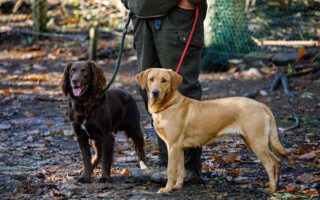In a world where our furry companions joyfully wag their tails at every opportunity, the art of dog training emerges as an essential dance between understanding and guidance. While traditional training methods often react to behavior issues, proactive dog training takes a step further, emphasizing prevention and anticipation in the relationship between humans and their canine counterparts. By cultivating a mindset that prioritizes proactive engagement, dog owners can empower their pets to thrive, fostering an environment that nurtures good behavior before challenges arise. This article delves into the principles and practices of proactive dog training, exploring how this forward-thinking approach not only enhances obedience but also deepens the bond between dogs and their humans, ensuring a harmonious home filled with wagging tails and joyful barks.
Table of Contents
- Harnessing the Power of Prevention in Dog Training
- Cultivating Positive Behaviors through Early Intervention
- Creating a Structured Environment for Success
- Building a Strong Bond through Engaging Training Techniques
- Q&A
- In Retrospect
Harnessing the Power of Prevention in Dog Training
In the realm of dog training, the concept of proactivity takes on a transformative role, allowing trainers and dog owners to anticipate potential challenges before they escalate. By establishing a well-rounded foundation of commands and behaviors, owners can effectively shape their dog’s conduct in various situations. A proactive approach encourages the investment of time in teaching essential commands, such as sit, stay, and come, creating a vocabulary your dog understands. When you utilize these commands consistently, you not only reinforce desired behaviors but also create an environment where your dog feels secure and empowered. This fosters a mutual understanding that significantly reduces stress for both the dog and its owner.
Moreover, the power of prevention is amplified through early socialization and exposure to different environments. A well-socialized dog is less prone to develop issues such as anxiety or aggression. Consider the following strategies to enhance the effectiveness of your training:
- Controlled Socialization: Introduce your dog to other pets and people in a safe environment to build confidence.
- Positive Reinforcement: Reward good behavior consistently to encourage your dog’s willingness to learn.
- Routine Establishment: Set daily training sessions to establish reliability and predictability.
Incorporating these elements leads to a comprehensive training experience that prioritizes prevention, ensuring that any potential behavioral issues are addressed before they manifest. Through a meticulous and thoughtful approach to training, owners can create a harmonious relationship with their dogs, grounded in trust, respect, and understanding.
Cultivating Positive Behaviors through Early Intervention
Proactive dog training focuses on instilling positive behaviors in your furry friend from an early age. By addressing potential issues before they manifest into habits, owners can foster a harmonious relationship and ensure that their canine companions thrive. Here are some key elements that can help in this process:
- Consistency: Establishing a routine helps dogs understand expectations.
- Positive Reinforcement: Rewarding desirable behaviors encourages repetition.
- Socialization: Early interactions with other dogs and environments build confidence.
- Clear Communication: Using simple commands creates a solid understanding between you and your pet.
This approach not only nurtures good behaviors but also prevents behavioral concerns from developing. Implementing early intervention strategies can be enhanced by utilizing tools like clicker training, which marks desired behavior with a distinct sound, followed by a treat. To further illustrate the importance of early intervention, consider the following table:
| Behavior | Before Training | After Training |
|---|---|---|
| Jumping on People | Frequent and unwanted interaction | Calm greetings |
| Barking at Strangers | Alertness or fear | Calm demeanor |
| Pulling on Leash | Unpleasant walks | Enjoyable strolls |
Creating a Structured Environment for Success
To foster an atmosphere that promotes effective learning, it is important to first establish clear boundaries and routines. Dogs thrive on consistency and predictability, which helps them feel secure in their environment. Consider implementing the following strategies:
- Defined Spaces: Designate specific areas for training, play, and rest to help reinforce the differences between various activities.
- Scheduled Training Sessions: Regularly scheduled sessions can help your dog anticipate and prepare for learning, making them more engaged during training.
- Positive Reinforcement Zones: Create areas where rewards can be given freely, enhancing the association between good behavior and positive outcomes.
Additionally, structuring the training environment involves eliminating distractions and maximizing focus. Start by minimizing external stimuli that could draw attention away from learning. To further streamline the process, you might consider creating a visual schedule:
| Time | Activity |
|---|---|
| 8:00 AM | Morning Walk & Basic Commands |
| 1:00 PM | Lunch & Playtime |
| 6:00 PM | Evening Training Session |
This structured approach not only helps in building a responsible behavior routine but also strengthens the bond between you and your dog, setting the stage for lasting success in training efforts.
Building a Strong Bond through Engaging Training Techniques
Establishing a connection with your dog goes far beyond the basics of commands and obedience; it embodies an enriching experience where training becomes a shared journey. Utilizing engaging training techniques not only fosters skill development but also enhances the emotional bond you share with your furry friend. Consider integrating interactive games into your training routine, such as playing hide-and-seek or utilizing puzzle toys that require problem-solving. This approach encourages your dog to focus and cooperatively engage, creating a mutually rewarding experience that strengthens your relationship.
Another effective strategy is the incorporation of positive reinforcement through fun activities. Instead of relying solely on treats, you can use toys, praise, or even a favorite game as rewards. This diversity in incentives keeps your dog’s interest piqued and makes training sessions enjoyable. Below is a simple table showcasing a few engaging techniques and the benefits they offer:
| Training Technique | Benefits |
|---|---|
| Interactive Games | Promotes teamwork and communication |
| Puzzle Toys | Encourages problem-solving and mental stimulation |
| Clicker Training | Enhances clear communication and timing |
| Outdoor Adventures | Builds teamwork and social skills |
Q&A
Q&A: The Essentials of Proactive Dog Training
Q1: What is proactive dog training?
A1: Proactive dog training is an approach that emphasizes prevention and preparation. Instead of waiting for behavioral issues to arise, this method involves training your dog to respond positively to various situations and stimuli. It encourages good habits, socialization, and communication, creating a strong foundation for a healthy and responsive relationship between a dog and its owner.
Q2: How is proactive training different from reactive training?
A2: Reactive training focuses on addressing existing behavioral problems after they have occurred, often leading to a cycle of correction and discipline. In contrast, proactive training aims to preemptively teach desirable behaviors and responses to avoid potential issues. This forward-thinking strategy fosters a more harmonious relationship by equipping dogs with skills to navigate their environment confidently.
Q3: What are some key benefits of proactive dog training?
A3: Some of the main benefits include improved obedience, reduced anxiety in dogs, better socialization skills, and fewer behavioral issues overall. By investing time and energy into proactive training, owners can cultivate a calm and well-adjusted pet, leading to a more enjoyable companionship and a smoother daily routine.
Q4: What techniques can pet owners use to implement proactive training?
A4: Some effective techniques include consistent socialization from a young age, positive reinforcement methods (like treats and praise), establishing a structured routine, and engaging in regular training sessions that focus on commands and good manners. Incorporating impulse control exercises and exposure to various environments can also help create a well-rounded dog.
Q5: At what age should proactive training begin?
A5: Ideally, proactive training should start as early as possible, even before a puppy reaches eight weeks old. However, it’s important to tailor your approach to your dog’s age, temperament, and individual needs. Older dogs can also benefit from proactive strategies, especially when transitioning into new living situations or lifestyles.
Q6: Are there specific behaviors that should be prioritized in proactive training?
A6: Yes! Important behaviors to focus on include basic commands like sit, stay, and come; leash manners; impulse control; and socialization skills with other dogs and people. Additionally, addressing common triggers—like loud noises or unfamiliar environments—can help your dog respond calmly in challenging situations.
Q7: How can owners assess the effectiveness of their proactive training efforts?
A7: Owners can evaluate the success of their proactive training through regular observations of their dog’s behavior in various situations. Key indicators include improved response to commands, reduced anxiety during encounters, and overall ease in navigating new environments. Keeping track of milestones and celebrating small achievements can also enhance motivation for both the dog and owner.
Q8: Can proactive dog training be beneficial for older dogs?
A8: Absolutely! Although proactive training is often associated with puppies, older dogs can greatly benefit from it as well. It can help reinforce good habits, reduce anxiety, and even assist in adjusting to new routines or environments, proving that it’s never too late to enhance communication and strengthen the bond between a dog and its owner.
Q9: How can pet owners stay motivated throughout the proactive training process?
A9: Staying motivated often requires setting realistic goals, celebrating incremental progress, and finding joy in the training process itself. Engaging in fun activities, incorporating play, and joining training classes or groups can also keep energy levels high and spirits lifted. Remember, the journey of training is just as important as the destination.
By embracing a proactive approach to dog training, you can foster a deeper connection with your furry companion while equipping them with the skills they need to thrive in the world around them.
In Retrospect
As we conclude our exploration into the world of proactive dog training, it’s clear that this approach transcends mere obedience. It fosters a deeper bond between you and your canine companion, paving the way for a harmonious coexistence. By anticipating needs, reinforcing positive behaviors, and communicating effectively, we can create an environment where both dogs and humans thrive.
Remember, every wagging tail tells a story, and every bark carries a lesson. Proactive training isn’t just about teaching commands; it’s about understanding the unique language of your dog and responding with patience and creativity. As you embark on this rewarding journey, embrace the small victories and learn from the challenges. Your commitment to a proactive mindset will not only shape your dog’s behavior but will also enrich your shared experiences.
So, take a deep breath, gather those training treats, and step into the adventure ahead. With every session, you’re not just training a dog; you’re nurturing a lifelong friendship. Here’s to many joyful moments filled with growth, laughter, and learning—together.


